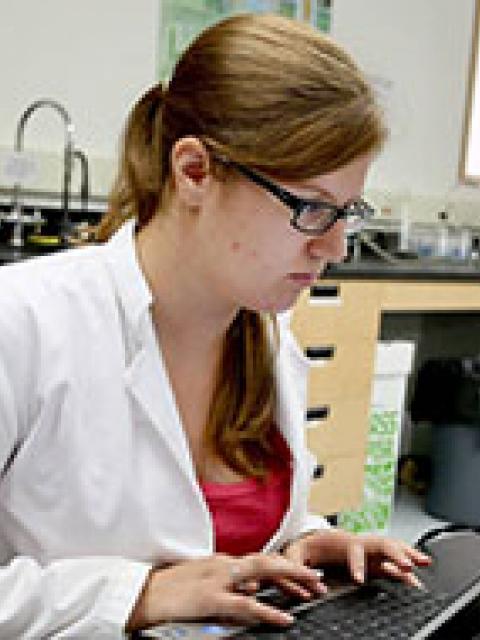
Alison Anson
Environmental Sociology at Colorado State University
Faculty Mentor: Nels Paulson
Research Project: The Social Network to Improve Water Quality in the Red Cedar Basin: Challenges and Opportunities
My name is Alison Anson. I am a senior at Colorado State University studying Environmental Sociology and Political Science. I am curious about the relationship societies have to the natural world and am passionate about making this the most positive relationship possible. I strongly believe that this relationship starts with interdisciplinary work to create a holistic perspective on significant environmental issues. When I am not planning how to solve all of the world’s environmental problems, I like to spend my time outdoors: running, hiking, climbing, and exploring! Living in different parts of the United States has allowed me to see many different perspectives of our natural environment and I am always eager to learn more. I love learning at a university but I especially enjoy opportunities, such as this REU, to get hands on experience in natural environments.
The Social Network to Improve Water Quality in the Red Cedar Basin: Challenges and Opportunities
View Research Project Here
The way we perceive our social environment and the way we connect with our community matters. More specifically, social capital (the amount of empowerment, efficacy, participation, and trust one has within a community) matters.
If communities are to find solutions to environmental problems, we must first understand how we, as a society and community, view these problems and are able to utilize our community resources to create lasting solutions.
For two months, I studied the social network of people most closely associated with water quality policy in the Red Cedar Basin. Not only have I studied who is connected to whom, but I have also studied what values each of these individuals have.
I chose to focus on how the level of social capital each of these individuals had influenced their views or expectations of a leader. Our findings show that the type of social capital an individual has is significantly correlated with valuing some leadership qualities over others.
For example, if someone has a higher general social capital (higher frequency of attending various community events), they are 80% more likely to value ‘social connections with the right people’ as a leadership trait and 41% more likely to value ‘the ability to make others feel empowered’ as a leadership trait. However, these traits are not valued as highly among individuals with higher diverse social capital (those who greatly value diversity and differing perspectives in the workplace) and higher leadership social capital (those who plan and organize events and are seen as a leader or sought out for advice).
In fact, an individual with higher diverse social capital is 35% less likely to see ‘the ability to make others feel empowered’ as an important leadership skill and an individual with higher leadership social capital is 19% less likely to see ‘the ability to make others feel empowered’ as a leadership trait. However, these traits are not valued as highly among individuals with higher diverse social capital (those who greatly value diversity and differing perspectives in the workplace) and higher leadership social capital (those who plan and organize events and are seen as a leader or sought out for advice).
Through survey responses we were able to conclude that individuals with higher diverse social capital attended farm field days and other similar events more frequently, and those with higher leadership social capital planned these types of events more frequently. While good listening and communication is important, putting farmers in leadership roles and empowering them may be the most important way to have a more cohesive form of policy implementation.
How individuals within this social network prioritize leadership attributes matter and may influence the way policy implementation is conducted in the Red Cedar Basin. Within my analysis, 3 of 195 individuals identified in the network were farmers in the Red Cedar Basin. A social network that is more inclusive to all actors within the watershed could lead to more effective policy implementation and a greater understanding of the local environment. I hope to continue this research further and establish an even greater understanding of how these different types of social capital influence a variety of environmental and community behavior.

Cassandra Beckworth
Applied Social Science at the University of Wisconsin-Stout
Faculty Mentor: Nels Paulson
Research Project: What Do We Know about Farmers' Social Networks?
My name is Cassandra Beckworth. I’m currently going into my senior year at University of Wisconsin-Stout studying Applied Social Science with a concentration in Sociology and Anthropology. I am a complete animal and nature lover. In fact, I currently have ten pets (3 dogs, 2 cats, 2 rats, 2 horses, and 1 rabbit) which are all rescues. In my free time you’re likely to find me either on horseback or somewhere in the woods. This REU allowed me to study the local land and water, which I enjoy so much, as well as have a greater part in my community. My project focused on farmers and understanding the different impacts that personal relationships, connections, and usage of best management practices has on the local environment. I had a great summer and it was definitely an experience I would recommend.
What Do We Know about Farmers' Social Networks?
View Research Project Here
For this particular project, we surveyed and interviewed farmers asking about which best management practices (BMPs) they are currently using (if any), their environmental views, and who they would list as their five most trusted sources for farming related advice. In total, over a 190 surveys were distributed by mail, email and in-person to farm landowners with over 60 of those being delivered in-person. From the surveys and interviews, we were able to generate a social network map (Figure 1-7). On the graph, circles represent the participants or those participants listed as sources of farming advice and lines represent the connections between participants. For example, participants are connected to whoever they listed as a trusted source for farming information. If an individual was listed by more than one participant then they have more connections to other individuals in the network, respectively.
Of 19 responds, there are 12 connected components symbolizing a social network that isn’t very well connected. From qualitative data and previous research, we were able to conclude that the lack of connections may be due to several different reasons including lack of trust, lack of opportunity and commitment to traditional practices. We also looked at Diffusion of Knowledge vs Groupthink which refers to how connected individuals are within the network and how that has an impact on how easily they will accept outside information. We also looked at the difference that farming one’s own land versus farming and renting another’s land has on individual ideology and BMP adoption. We were able to conclude the owners are more likely to be currently utilizing BMPs, more likely to agree that ecological impacts is an aspect that supports their adoption of BMPs, and more likely to agree that laws to protect the environment limit choices and personal freedom. Our results thus far suggest that if government agencies want to encourage BMP adoption they should consider focusing their efforts on those who are renting the land who are less likely to be using BMPs and more likely to want government involvement.

Kyle Corcoran
Environmental Hydrology and Biology at Western Carolina University
Faculty Mentor: Matt Kuchta
Research Project: Temporal and Spatial Variations in Phosphorous Concentration within the Red Cedar River Watershed
Kyle Corcoran. As a junior in Geology with an interdisciplinary concentration in Environmental Hydrology and Biology, I hope to use this undergraduate degree in order to pursue a graduate program in either Ecological Restoration or Hydrology. I have a strong interest in the environment and ecosystems, and long term would really like to work for a government agency or consulting firm to have the opportunity to work on ecological restoration and remediation projects. I am interested in being able to restore damaged lands in our natural environment and develop systems that will be able to sustain themselves once restored.
Temporal and Spatial Variations in Phosphorous Concentration within the Red Cedar River Watershed
View Research Project Here
Phosphorus is one of the key nutrients in sustaining healthy plant growth; however, if too much phosphorus is present within the a water system, it can lead to massive algal blooms. Excessive algae growth can release toxins and deplete dissolved oxygen concentrations as the algae decays. This leads to poor water quality, as seen in the lower Red Cedar River Watershed.
Previous research in the Red Cedar watershed has not investigated the background contribution of phosphorus from groundwater sources compared to surface water. Our research explores and identifies groundwater and surface water interactions.
Land use practices affect when phosphorus is transported downstream. In the Wilson Creek watershed the highest concentrations of soluble reactive phosphorus (SRP) and total phosphorus (TP) were observed downstream of sites where cattle were pastured, with the highest TP concentrations on the hottest days.
In the South Fork Hay River and Tiffany Creek watersheds the highest concentrations of SRP and TP were associated with large precipitation events. Rainfall events can cause sheet, rill, and gully erosion, which are able to transport phosphorus that is attached to sediment particles. Rain events also lead to increased discharge in streams, which can move phosphorus attached to sediment in the streambed, stream banks, and in larger events, even the floodplain.
We found elevated SRP and TP concentrations in some groundwater samples. A potential groundwater phosphorus source is located near the contact between the Mt. Simon and Eau Claire formations, which contain abundant phosphatic brachiopod shells. The widespread distribution of these bedrock units suggests background TP and SRP testing and sourcing should be done in order to best estimate total maximum daily phosphorus loads from individual streams.

Zakia Elliot
Environmental Studies at Brown University
Faculty Mentor: Tina Lee
Research Project: Understanding Environmental Policy Constraints in the Red Cedar Watershed
My name is Zakia Elliott and I am a rising senior attending Brown University in Providence, Rhode Island. I am concentrating in Environmental Studies and I am primarily interested in environmental law and policy, climate change, environmental justice and urban sustainability. I am a city person--my hometown is Philadelphia, Pennsylvania--though you'll just as likely see me hiking, camping and backpacking through the woods as you would hopping on and off public transportation, window shopping in Center City and taking walks through my neighborhood.
Understanding Environmental Policy Constraints in the Red Cedar Watershed
View Research Project Here
This research project aims to understand policy actors—practitioners, policy makers, officials and organization members—who influence the creation, implementation, enforcement and public perception of environmental regulations in the Red Cedar Watershed. This study focused on political actors’ views of land use and water pollution in the watershed, current policies and programs aimed at cleaning local lakes, and the decision-making behaviors behind current and proposed environmental policies.
Data were collected during participant observations at public meetings, such as County Board committee Meetings, City Council meetings, and strategic planning sessions. Additionally, 19 Interviews were conducted with policy actors at different agencies, levels of government, and NGOs, including actors from the Department of Natural Resources (DNR); Department of Agriculture, Trade, and Consumer Protection (DATCP); Natural Resources Conservation Service (NRSC); Dunn County Land Conservation Division (County LCD); Dunn County Board; City of Menomonie; University of Wisconsin-Extension (UW-Extension); and Tainter/Menomin Lake Improvement Association (TMLIA).
My findings reflect the complex political structure of environmental policy and legal and political constraints on policy makers. First, several agencies provide similar services such as technical assistance, programs and grants, which could cause confusion within the community and across agencies in terms of which entity is the leading agency for a particular issue, especially water quality.This is primarily reflected in the responsibilities and relationship between DNR, DATCP, County LCD and NRCS. Many respondents voiced a concern for funding for staff positions and activities for cost-sharing, which is impeded by a lack of political support from the federal and state government. Additionally, there is a shift away from traditional enforcement of environmental policy toward providing incentives for voluntary compliance and behavioral change. More funding directed toward staffing positions to do the one-on-one consultations is needed to build trust and change norms is crucial. In addition, more communication and directed leadership within and across agencies is recommended.

Matthew Flyr
Economics at St. Mary’s College
Faculty Mentor: Chris Ferguson
Research Project: Estimating Willingness to Pay for a Cleaner Lake Menomin: A Contingent Valuation Study
Matthew Flyr. I’m a junior at St. Mary’s College of Maryland studying economics with a focus in environmental and natural resource economics. But don’t let the economics title paint the wrong picture—I’m not going to be an economist who sits at a desk all day crunching numbers or running regressions and “changing the world” from the safe confines of my office. I love being outside and interacting with the world, and hope that my future work as an environmental economist will allow me to do both. When I take a break from discovering the next greatest economic theory, I’m a captain of the St. Mary’s cross country team, a triathlete (sprint distance, I’m not crazy), a rock climber, and a lover of most outdoor activities. If I’m not outside (and often even when I am outside), you can find me with a novel in one hand, black tea with milk and sugar in the other.
Estimating Willingness to Pay for a Cleaner Lake Menomin: A Contingent Valuation Study/
View Research Project Here
The purpose of this project was to understand how much people in and around Menomonie, WI value a cleaner Lake Menomin and to discover which variables significantly influence that value. Determining an individual’s value for something bought on sold in a market (e.g. an iPod) is easy—you just look at the price and see if an individual purchases the good at that price! But for things not bought or sold in a market (e.g. a natural resource like Lake Menomin), valuation is more difficult. To get at people’s value for Lake Menomin, I used a process called “contingent valuation,” whereby I distributed surveys that asked whether people would be willing to pay for three different policies—a 0.1% additional sales tax, a $10 monthly water bill addition, and a $120 annual property tax addition. Through these willingness to pay questions, I essentially imposed a “price” on a cleaner Lake Menomin. If a respondent stated he or she would vote for a cleanup policy at that price, I know he or she values a cleaner lake at at least that price.
I found that a sales tax addition of 0.1% was by far the most popular of the three proposed policy solutions, with 89% support compared to 43% support for property tax and 52% for water bill. Using econometric modeling (a random effects logit regression), I found that the average respondent was actually willing to pay more than an additional 0.1% sales tax, and would in fact be willing to pay annually $65.31 in additional sales tax (roughly a 0.4% sales tax). In other words, the average citizen places a value of $65.31 annually on a cleaner Lake Menomin (this dollar value changes if you look at how much the average respondent would be willing to pay in property tax or water bill additions). I also found that a respondent is 146% (about 2.5 times) more likely to support a 0.1% sales tax if he or she believes agricultural runoff to be a major source of lake pollution, and 295% (almost 4 times) more likely to support the tax if it keeps the Lake clean for the entire summer (as opposed to an extra month). These results are especially relevant for policymakers concerned with Lake Menomin, as I show that a 0.1% sales ax addition designated to cleaning the Lake would pass with an overwhelming majority of the popular vote (89%), and even a tax as high as 0.3% would pass with 50% of the vote. If a 0.1% sales tax addition were implemented in Dunn County (where Menomonie is located), around $380,000 in annual revenue could be generated. If you have any questions about my process or my results or anything else you’ve read here, feel free to email me at mflyr@smcm.edu.

Rachel Frana
Environmental Studies at Central College
Faculty Mentor: Tina Lee
Research Project: The Farmer-Led Initiative
Rachel Frana is a senior at Central College in Iowa, majoring in Environmental Studies.
The Farmer-Led Initiative
View Research Project Here
Within the past two years, the counties of Dunn, Pierce, Polk, and St. Croix have created farmer-councils with the aim of improving soil health and water quality within the agricultural community. The ultimate goal is to facilitate better farming practices upstream that will help clean up pollution in lakes Menomin and Tainter. The LAKES REU researched the farmer-led initiative to better understand what it is and how it works. The findings are as follows:
Prior to the farmer-led councils, the county had little power to enforce environmental regulations, especially when many desirable farming practices are completely voluntary. The farmer-led councils take a different approach to enforcement, choosing instead to create a sense of community between farmers and provide education and resources. Using private money from the McKnight Foundation, the farmers decide which incentives to use to encourage environmentally friendly farming practices.
The councils also work to rebuild trust between the farming community and the county. Some farmers are weary of working with government officials, put off by previous experiences with regulation. Interestingly, the farmer-led councils seem to attract farmers who generally dislike government interference. These farmers hope that by taking a proactive approach, they can potentially stave off more regulation.
Many people are excited by the potential of the farmer-led initiative, yet a few barriers exist that could slow progress. The long-term sustainability of funding is one concern. One of the largest challenges to finding incentive money is the need for funding that is free from “strings attached.” The farmer-led councils must have flexible funding available for them to use as they see fit.
The county departments involved in creating the farmer-led councils also face financial constraints. Time is money, and it takes a lot of time to build relationships between the farmers within each council and between the council and the county. Currently, each county has dedicated one employee to work with the councils part-time on the farmer-led initiative. In order for the farmer-led initiative to expand, however, more paid staff time may be necessary in the future.
The farmer-led initiative shows a lot of promise for improving soil health and water-quality within the region. It is important to note that the farmer-led initiative is a long-term project that has only just begun. It will take more time to see results. The LAKES REU plans to continue monitoring the initiative over the next two years to see how it progresses.

Blake Lea
Environmental Geoscience at Winona State University
Faculty Mentor: Matt Kuchta
Research Project: Temporal and Spatial Variations in Phosphorous Concentration within the Red Cedar River Watershed
Hi, my name is Blake Lea and I am currently a senior at Winona State University in Winona, Minnesota. I am studying environmental geoscience and biology at Winona State focusing on hydrology, fisheries biology, and water chemistry. I be graduating in December of 2014 and plan on taking a semester off and working before going to grad school.
Research Project: Temporal and Spatial Variations in Phosphorous Concentration within the Red Cedar River Watershed
View Research Project Here
Phosphorus is one of the key nutrients in sustaining healthy plant growth; however, if too much phosphorus is present within the a water system, it can lead to massive algal blooms. Excessive algae growth can release toxins and deplete dissolved oxygen concentrations as the algae decays. This leads to poor water quality, as seen in the lower Red Cedar River Watershed.
Previous research in the Red Cedar watershed has not investigated the background contribution of phosphorus from groundwater sources compared to surface water. Our research explores and identifies groundwater and surface water interactions.
Land use practices affect when phosphorus is transported downstream. In the Wilson Creek watershed the highest concentrations of soluble reactive phosphorus (SRP) and total phosphorus (TP) were observed downstream of sites where cattle were pastured, with the highest TP concentrations on the hottest days.
In the South Fork Hay River and Tiffany Creek watersheds the highest concentrations of SRP and TP were associated with large precipitation events. Rainfall events can cause sheet, rill, and gully erosion, which are able to transport phosphorus that is attached to sediment particles. Rain events also lead to increased discharge in streams, which can move phosphorus attached to sediment in the streambed, stream banks, and in larger events, even the floodplain.
We found elevated SRP and TP concentrations in some groundwater samples. A potential groundwater phosphorus source is located near the contact between the Mt. Simon and Eau Claire formations, which contain abundant phosphatic brachiopod shells. The widespread distribution of these bedrock units suggests background TP and SRP testing and sourcing should be done in order to best estimate total maximum daily phosphorus loads from individual streams.

Lauren L’Esperance
Environmental & Natural Resource Economics at the University of Rhode Island
Faculty Mentor: Chris Ferguson
Research Projects: Understanding Trends in Farmer BMP Adoption
Lauren L’Esperance lives in Narragansett, RI and attends the University of Rhode Island (URI). She will be graduating in December 2014 with a B.A. in Environmental & Natural Resource Economics and minors in both Sustainability and International Development. She is particularly interested in small- and medium- scale agriculture, the environmental impacts of agriculture, global commodities trading, and international subsistence farming. While at URI, she has led environmental community service projects and initiatives and been an active member in URI’s environmental economics student group, as well as various academic societies. Lauren also spent a semester studying and researching in New Zealand, carrying out a biodiversity assessment of native forest remnants on a farm as a basis to determine economically viable options for sustainable land management. While in the country, she also volunteered with the WWOOF (World Wide Opportunities on Organic Farms) organization where she first cultivated her passion for farming.
Understanding Trends in Farmer BMP Adoption
View Research Project Here
Agriculture makes up the largest piece of the economic pie here in the Red Cedar Watershed. As part of a research program with the goal of addressing water quality issues in the watershed, I surveyed Wisconsin farmers to understand trends in BMP adoption by capturing the economic landscape of Wisconsin farms. Best Management Practices (BMPs) are ecologically sensitive alternatives to conventional farming practices. Soil loss and declining soil health are of heightening concern to Wisconsin farmers, policymakers, and citizens as these issues can be detrimental to profits and yields and can damage water quality through sedimentation and nutrient loading. BMPs can mitigate soil loss, but their effectiveness is still debated.
As I excavated through the massive piles of returned surveys and journeyed through the world of statistical software, I found answers to important questions:
1) Which incentives do farmers find to be effective in easing their transition to BMPs?
I found that farmers find technical help and education programs to be helpful incentives, along with the farmer-led councils that often provide these two incentives. The value placed on education and technical help is true for all farm types and sizes. On average, these incentives are more helpful than easement programs, tax breaks, and subsidies.
2) How interested are farmers in participating in education programs?
I determined that 23% of respondents have high interest in education, having mostly attended a variety of education programs. Likewise, 28% of respondents have medium interest in education, expressing interest in relevant education programs of all types as well as having participated in some education programs. Finally, 49% expressed low interest, being only interested in some or no education programs.
3) To what extent are farmers currently using BMPs?
This survey asked farmers about their use of conservation easements, crop rotation/cover crops, conservation tillage, waterway buffer zones, manure management, and fencing off livestock from waterways. I found that 45% of respondents are high adopters of BMPs, whereas only 33% are medium-level adopters and 22% are low adopters. This revealed that a large portion of farmers use a combination of various BMP options available.
4) Which variables and factors influence adoption of BMPs?
I found that various factors have significant impact on a farmer’s level of BMP adoption. For each additional
incentive a farmer uses, their BMP adoption increases by 3.2% and for each unit increase in the frequency of soil testing, BMP adoption increases by 7.2%.
Those farmers in younger age groups increase their BMP adoption by 6.1%. This means that younger farmers are more readily adopting BMPs. Also, farmers that have children have a BMP adoption rate that is 9.5% higher than that of farmers without children. This could be due to an investment and interest in future generations.
On average, the prospect of increased profits and yield in the long-run encourages farmers of all farm types to adopt BMPs, whereas current policies and capital costs are generally perceived to have a more negative than positive impact on BMP adoption, often hindering adoption.
Overall, I learned an immense amount about farmer BMP adoption, but most importantly, I learned about the importance of connecting with others. The connections made between citizens, policymakers, and farmers via our research are making a profound difference in this community primarily because this research program aims to work with community members, not study them. I urge this community to continue building positive relationships with one another to address water quality issues and I am eager to return to this region of the country to witness the impact of our collective research.
Agriculture makes up the largest piece of the economic pie here in the Red Cedar Watershed. As part of a research program with the goal of addressing water quality issues in the watershed, I surveyed Wisconsin farmers to understand trends in BMP adoption by capturing the economic landscape of Wisconsin farms. Best Management Practices (BMPs) are ecologically sensitive alternatives to conventional farming practices. Soil loss and declining soil health are of heightening concern to Wisconsin farmers, policymakers, and citizens as these issues can be detrimental to profits and yields and can damage water quality through sedimentation and nutrient loading. BMPs can mitigate soil loss, but their effectiveness is still debated.
As I excavated through the massive piles of returned surveys and journeyed through the world of statistical software, I found answers to important questions:
1) Which incentives do farmers find to be effective in easing their transition to BMPs?
I found that farmers find technical help and education programs to be helpful incentives, along with the farmer-led councils that often provide these two incentives. The value placed on education and technical help is true for all farm types and sizes. On average, these incentives are more helpful than easement programs, tax breaks, and subsidies.
2) How interested are farmers in participating in education programs?
I determined that 23% of respondents have high interest in education, having mostly attended a variety of education programs. Likewise, 28% of respondents have medium interest in education, expressing interest in relevant education programs of all types as well as having participated in some education programs. Finally, 49% expressed low interest, being only interested in some or no education programs.
3) To what extent are farmers currently using BMPs?
This survey asked farmers about their use of conservation easements, crop rotation/cover crops, conservation tillage, waterway buffer zones, manure management, and fencing off livestock from waterways. I found that 45% of respondents are high adopters of BMPs, whereas only 33% are medium-level adopters and 22% are low adopters. This revealed that a large portion of farmers use a combination of various BMP options available.
4) Which variables and factors influence adoption of BMPs?

Peng Vang
Mathematics at St. Cloud State University
Faculty Mentor: Steve Nold
Research summary is not available.
Phosphorus and Chlorophyll Dynamics in a Nutrient Impacted Watershed
View Research Project Here

Courtney Worthington
Biology at Coe College
Faculty Mentor: Steve Nold
Research summary is not available.
Phosphorus and Chlorophyll Dynamics in a Nutrient Impacted Watershed
View Research Project Here




